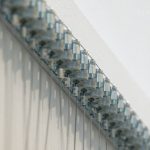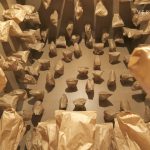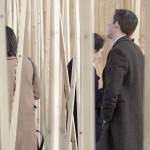At Haus Konstruktiv in Zürich (Switzerland), the Swiss artist Zimoun presents two immersive room and sound installations. The artworks are made from simple everyday industrial materials, which also give the to the artworks and the exhibition: 295 prepared dc-motors, 39 kg wood, and 825 cardboard boxes 35 x 32.5 x 32.5 cm. Curated by Sabine Schaschl and Eliza Lips, the exhibition is on view until September 12, 2021. In this video, we have a look at the exhibition and Sabine Schaschl (Director and Chief Curator, Haus Konstruktiv) provides us with an introduction to the artist and his work.
Zimoun: 295 prepared dc-motors, 39 kg wood, 825 cardboard boxes 35 x 32.5 x 32.5 cm. Solo Exhibition at Haus Konstruktiv, Zürich. Press preview, Zürich (Switzerland), June 8, 2021.
–– Right-click (Mac: ctrl-click) this link to download Quicktime video file.
Press text:
Haus Konstruktiv’s solo exhibition on Zimoun is the largest ever dedicated to this Bernese artist in a Swiss museum. It presents two immersive room and sound installations, which the artist has made from simple everyday and industrial materials, and adapted to the venue’s architectural givens.
Cardboard boxes, metal disks, wooden sticks, felt balls – as banal as the objects that Zimoun (b. 1977) uses in his artistic practice may seem, the effect they have in the exhibition space is spectacular: Hundreds of them, arranged according to certain principles (in grid formation, for example) are set in motion and made to emit sounds with the aid of just as many direct-current motors. Visual and acoustic patterns, generated in a partly random way, immerse the observer in a delightful monotony that is repetitive and multifaceted at the same time.
Zimoun’s solo exhibition at Museum Haus Konstruktiv is called 295 prepared dc-motors, 39 kg wood, 825 cardboard boxes 35 x 32.5 x 32.5 cm. In this title, the artist neatly lists the quantities and measurements of the materials that he has used in the two installations conceived specially for this museum. For years, such inventory lists have served as names for his artistic projects, exhibitions and individual works. They mark the end of a lengthy work process, in which the artist selected and coordinated the various materials, with their on-site spatial and acoustic interplay a key factor, as was the case in Zurich. The result may seem chaotic, but the works are based on comprehensible systematics, because Zimoun is a tinkerer with a system.
Marking the start of the exhibition, the floor installation 191 prepared dc-motors, 39 kg wood takes up a large area in the hall on the first floor with its rectangular basic form. It comprises 191 narrow wooden sticks, each of which is connected to a motor via a crank. Unhurriedly and jerking slightly, the drive units move the wooden sticks back and forth, left and right. The individual modules are arranged so that, without getting in each other’s way, they merge to form one dynamic overall body. And yet there is still room for the unexpected: The handmade elements cannot be completely tamed or smoothly coordinated. From time to time, they touch each other or cause the contours of the object as a whole to fray.
Since as long ago as the late 1950s, there have been representatives of kinetic art, such as Gianni Colombo and Gerhard von Graevenitz, intensively addressing mechanically generated movement and calculated chance. Zimoun’s art is loosely linked to these historical positions, but also differs from them, as Zimoun is less interested in movement per se than in the sounds it produces. His search for a dense analog soundscape of noises has played a crucial role.
The markedly reduced aesthetics of Zimoun’s installations also open up references to minimal art and minimal music, engagement with which is underlined by the installation 104 prepared dc-motors, 825 cardboard boxes 35 x 32.5 x 32.5 cm, presented on the second floor: another large-scale work, for which hundreds of cardboard boxes have been stacked in a seemingly casual manner, in groups of three. Some are equipped with a motor, to which a weight has been attached. The imbalance created by the rotation of these ‘pendulums’ sets the boxes in fitful motion at varying speeds. As a result of the stacking, the entire structure wobbles. Repetitive scratching, rubbing and scraping noises are produced, the abundance of which turns the exhibition space into a body of sound. Placed on the floor, the sculptural body comprising (almost) cube-shaped individual objects is reminiscent of American minimalist works from the 1960s and 1970s, for example by Donald Judd. Unlike Judd’s highly polished and accurately positioned cubes though, Zimoun’s exhibit is made of simple, loosely stacked cardboard, also giving rise to connections with the material aesthetics of Italian arte povera from the same period.
What Zimoun’s latest installations have in common with many of his earlier works is that the acoustic patterns generated by a few mass-produced industrial products initially bring to mind natural sounds, such as rain or the rustling of leaves. This is an interesting aspect of the exhibition, given that Museum Haus Konstruktiv is concerned with the heritage of constructivist-concrete art. The latter’s engagement with the materiality of art is often associated with firm exclusion of nature. Zimoun belongs to a new generation of artists who, despite maintaining a concrete approach to the materials they use, or drawing on key artistic strategies such as repetition and variation of certain basic elements, reflect the intertwining of nature and culture in their work. In particular, this is conveyed by his efforts to produce art in a sustainable manner: His works are laboriously documented on film and in photographs, so that the motors and wooden sticks can be used again and again, whereas the newly produced cardboard boxes are given to educational institutions for further use.
With clever references to art history, Zimoun’s sound-filled room installations or room-filling sound installations develop a strong presence in the here and now. While letting the observer actively perceive the exhibition situation in all its ambivalence, between simplicity and complexity, order and chaos, individuality and mass, they simultaneously provide a lasting experience for the eye and ear.
Zimoun was born in 1977 and grew up near Bern. He played various musical instruments as a child and started notating compositions of his own at a very young age. He presented early musical and visual works in 2010 at Tonus Labor (now Orbital Garden) – an experimental recording, teaching and performance space in Bern, where he still appears regularly today. Zimoun has realized numerous acoustic performances at music festivals and concert halls, for instance at the Royal Academy of Music in Aarhus, DNK (2017), Dampfzentrale Bern, SWI (2015/2017), Transmediale in Berlin, GER (2009), and the Elektra Digital Art Festival in Montreal, CAN (2008). As part of a three-month artist-in- residence scholarship in the People’s Republic of China (2004), he gave 15 live performances in as many Chinese cities. He has also featured in solo* and group exhibitions in Switzerland and abroad, at institutions such as Museo de Arte Contemporáneo in Santiago, CHL (2019), NYUAD Art Gallery, Abu Dhabi, UAE (2019), the Museum of Contemporary Art in Busan, KOR (2018), Centquatre, Paris, FRA (2017), Musée des beaux-arts in Le Locle, SWI (2016/2017)*, Taipei Fine Arts Museum, TWN (2016), Kunstmuseum Bern, SWI (2013), and Nam June Paik Art Center in Seoul, KOR (2012).
In addition to his work as an artist, Zimoun co-runs the label leerraum [ ], a platform for artists, architects, musicians and designers who address reductive principles, together with graphic designer Marc Beekhuis. Zimoun lives in Bern.






